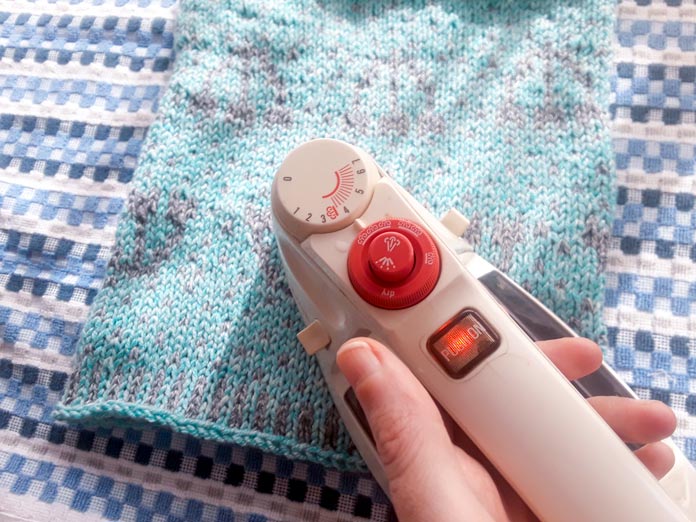After mastering how to catch floats in stranded knitting in yesterday’s post, today we move on to the final (and very satisfying!) step in completing the Holland Cowl — blocking. Knit with UNIVERSAL YARN Mystical Marl, a soft and durable cotton-acrylic blend, this cowl holds its shape beautifully — but like most stockinette-heavy projects, it’s prone to curling at the edges. In this post, I’ll show you how to block an acrylic blend properly to reduce curl, even out tension, and give your cowl a polished finish that lasts.

The Holland Cowl curls at the top and bottom because the stocking stitch, by nature, curls!
What is blocking? Blocking is the final step in finishing your knitting – it’s basically stretching your knits out to help even out your tension across the entire finished object. It’s especially important in lace to take your lace from a crumpled mass to beautiful lacework. With the Holland Cowl, however, it’s something a little different.
In most cases, blocking is done by getting the object wet, either by steaming it or by immersing it in water. For anything knit in acrylic, or a majority acrylic blend like the Mystical Marl yarn, the process is a little different, however. If you take an acrylic yarn and try to wet-block it, it won’t work. Acrylic is basically a form of plastic, and doesn’t really care too much about getting wet.
For acrylic yarns, you need heat to block them – but too much heat and you’ll quite literally melt the acrylic! This is called ‘killing’ the acrylic, and, if done on purpose, can produce an incredibly beautiful and drapey fabric! It’s great for lace shawls, but that’s not what we’re doing today.
So, how do you block acrylic?
There are three ways.
If you have a garment steamer, you can use that. I don’t own one, so onto the next option.
You can block acrylic with a steam iron – make sure it’s at the lowest possible steam setting. If your iron has an ‘acrylic’ setting, even better! Get your finished knitwear damp, then give it a gentle press—or, for a highly textured pattern that you don’t want to squish, like cables, textured knits, and purls, hold the iron just above the surface of the knit.
For the Holland Cowl, since it had no textured stitches to worry about, I went and pressed it. Not only does that help with evening out any spots of tension weirdness, but pressing it also really helped with that pesky curl at the top and bottom!

Blocking the Holland Cowl with a steam iron, so that the Mystical Marl yarn is blocked and the top and bottom edges no longer curl!
The nice thing about blocking acrylic and acrylic blends is that once you’ve blocked it once, it’s done. You’ll never have to block it again. The downside of blocking acrylic and acrylic blends is that once you’ve done it, it’s done! So if you over-block your finished knit, you can’t undo it!
Start slowly, and always stay on the lowest heat possible. Don’t crank the heat to speed up the process – you can’t undo this! If you’re worried about too much heat, you can put a damp towel on top of your knit to help slow down the heat transfer, but this is one of those things where you want to err on the side of caution.
Blocking the cowl this way took me about 20 minutes, but it made the bottom and top edges so much neater! They do still curl a tiny bit, but that may be the pattern – or I may try and block it a bit more later – I have not yet decided!

The Holland Cowl is blocked, finished and ready to be worn!
After that? Now it’s done, and I’m really happy with the results. I took it out to a local coffee shop and got some compliments on it, so I definitely consider that a job well done! Plus, it’s already served me well during the recent cool fall nights. Despite my initial skepticism around the UNIVERSAL YARN Mystical Marl, I was absolutely disproven, and now I have a new favorite cowl! Until next time!
This is part 5 of 5 in this series
Go back to part 4: How to catch floats in stranded knitting
